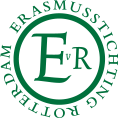Gedicht
Nuno Júdice
D.H. LAWRENCE’S FIGS
Lawrence recommended that the fig be divided intointo four pieces, for eating, after discarding
the skin. In this way, he reasoned, society would not look
askance upon the act of cutting open the fig and of
savoring it slowly, as one would read a poem. But
not all figs can be eaten in such a way; and
in the case of green figs, it’s better to skin them from
the top down, without separating the skin completely
from the fruit; it’s only after eating the top part, that
the moment arrives where there is only a bit of fig left
clinging to its skin. Then you can finally pluck it, and finish
eating what is left, for the meal to be complete.
Indeed, Lawrence also acknowledges this solution (and
also says it’s okay to eat the skin); but we must
go even further than he does, which means that we must
also consider the tree itself. And if, while we’re eating
the fig, the tree grabs our soul with its rough
branches, making it necessary to pull back its leaves to see how
it is we can escape beneath it, the taste which lingers in the mouth
recalls the image of the primitive woman, with her round womb
like the one of the early figs of Saint John, the first ones, that are gathered up
whole, in one sweep of the hand. So, my hand
becomes an extension of the fig tree, and I begin to think
that perhaps fig leaves will start growing from my arms,
as though they were branches; and that these leaves will hide
the figs that I will gather, keeping them fresh.
Alternatively, I could transform the trunk of the fig tree
into the body of a naked woman; and these leaves would adorn her. But the fig
that I have in my hand will make me feel her soft breasts, making
it seem like in stripping the skin from the fig the woman might appear from within,
and I would reach the same conclusion as Lawrence about
the many ways to eat a fig.
© Translation: 2007, Martin Earl
DE VIJGEN VAN D.H. LAWRENCE
Lawrence beval ons aan een vijg in vierente breken, om hem te eten, na de schil te hebben
weggegooid. Aldus, dacht hij, zou de maatschappij
zich niet storen aan het gebaar van het snijden van de vijg, en
er langzaam van smullen, als wie een gedicht leest. Maar
niet alle vijgen laten zich zo eten; en
in het geval van groene vijgen kan men beter de schil van bovenaf
eraftrekken, zonder dat die helemaal losraakt
van de vrucht; en pas nadat men het bovenste deel gegeten heeft
komt het moment dat slechts een beetje vijg de schil
nog vasthoudt. Tegen die tijd kan men de schil lostrekken, en eten
wat over is, opdat de maaltijd volmaakt zij.
In feite keurt Lawrence deze methode ook goed (en
hij accepteert zelfs dat men de schil opeet); maar we moeten
verder gaan dan hij, hetgeen betekent
dat we ook moeten denken aan de vijgenboom. En als de boom,
wanneer wij de vijg eten, ons bij de ziel grijpt met zijn ruwe
takken, en ons verplicht de bladeren opzij te duwen om te zien
hoe wij daaronder kunnen schuilen, dan doet de smaak die in de mond blijft
denken aan het beeld van de primitieve vrouw, met haar ronde buik
als die van de vijgen van Sint-Jan, de eerste, die men plukt
in een handomdraai en die men heel in de hand houdt. Dan wordt de hand
verlengstuk van de vijgenboom, en het komt nu in mij op
dat er misschien wel vijgenbladeren zouden kunnen groeien aan onze armen
alsof die takken waren; en die bladeren kunnen dan heel goed
de vijgen toedekken die ik ga plukken, om ze fris te houden.
Een andere optie is dat ik de stam van de vijgenboom verander in het lichaam
van een naakte vrouw; die bladeren zijn dan haar kleding. Maar de vijg
die ik in de hand heb zal mij haar zachte borsten doen voelen en zal maken,
wanneer ik de schil erafhaal, dat de vrouw eruit tevoorschijn komt,
en dat ik tot dezelfde slotsom kom als Lawrence omtrent
de vele manieren van vijgen eten.
© Vertaling: 2007, August Willemsen
OS FIGOS DE D.H. LAWRENCE
Lawrence aconselhou a que se partisse um figoem quatro pedaços, para o comer, depois de deitar fora
a casca. Deste modo, pensava ele, a sociedade não veria
com maus olhos o gesto de cortar o figo, e de o
saborear lentamente, como quem lê um poema. Mas
nem todos os figos se podem comer desta maneira; e,
no caso dos figos verdes, o melhor é tirar-lhes a pele a
partir de cima, sem que ela se desprenda completamente
do fruto; e só depois de comer a parte de cima, é que
chegará o momento em que só vai ficar um pouco de figo
a segurar a casca. Nessa altura, pode-se arrancá-la, e acabar
de comer o que sobra, para que a refeição fique completa.
De facto, Lawrence também admite esta solução (e
aceita que se coma também a casca); mas teremos
de ir mais longe do que ele, o que significa
que se deve também pensar na figueira. E se, ao comermos
o figo, a árvore nos agarra a alma com os seus ramos
ásperos, obrigando-nos a afastar as folhas para ver como
é que se pode fugir debaixo dela, o sabor que fica na boca
lembra a imagem da mulher primitiva, com o seu ventre redondo
como o dos figos de S. João, os primeiros, que se colhem
com um gesto só, ficando inteiros na mão. Então, a mão
torna-se um prolongamento da figueira, e começo a pensar
que talvez possam nascer folhas de figueira nos braços,
como se estes fossem ramos; e que essas folhas servirão para
tapar os figos que irei colher, mantendo a sua frescura.
Em alternativa, poderei transformar o tronco da figueira
num corpo de mulher nua; e essas folhas irão vesti-la. Mas o figo
que tenho na mão far-me-á sentir os seus seios macios, fazendo
com que, ao tirar a casca do figo, a mulher saia de dentro dele,
e eu possa chegar à mesma conclusão de Lawrence sobre
as múltiplas formas de comer um figo.
© 2006, Nuno Júdice
From: As coisas mais simples
Publisher: Dom Quixote, Lisbon
From: As coisas mais simples
Publisher: Dom Quixote, Lisbon
Gedichten
Gedichten van Nuno Júdice
Close
DE VIJGEN VAN D.H. LAWRENCE
Lawrence beval ons aan een vijg in vierente breken, om hem te eten, na de schil te hebben
weggegooid. Aldus, dacht hij, zou de maatschappij
zich niet storen aan het gebaar van het snijden van de vijg, en
er langzaam van smullen, als wie een gedicht leest. Maar
niet alle vijgen laten zich zo eten; en
in het geval van groene vijgen kan men beter de schil van bovenaf
eraftrekken, zonder dat die helemaal losraakt
van de vrucht; en pas nadat men het bovenste deel gegeten heeft
komt het moment dat slechts een beetje vijg de schil
nog vasthoudt. Tegen die tijd kan men de schil lostrekken, en eten
wat over is, opdat de maaltijd volmaakt zij.
In feite keurt Lawrence deze methode ook goed (en
hij accepteert zelfs dat men de schil opeet); maar we moeten
verder gaan dan hij, hetgeen betekent
dat we ook moeten denken aan de vijgenboom. En als de boom,
wanneer wij de vijg eten, ons bij de ziel grijpt met zijn ruwe
takken, en ons verplicht de bladeren opzij te duwen om te zien
hoe wij daaronder kunnen schuilen, dan doet de smaak die in de mond blijft
denken aan het beeld van de primitieve vrouw, met haar ronde buik
als die van de vijgen van Sint-Jan, de eerste, die men plukt
in een handomdraai en die men heel in de hand houdt. Dan wordt de hand
verlengstuk van de vijgenboom, en het komt nu in mij op
dat er misschien wel vijgenbladeren zouden kunnen groeien aan onze armen
alsof die takken waren; en die bladeren kunnen dan heel goed
de vijgen toedekken die ik ga plukken, om ze fris te houden.
Een andere optie is dat ik de stam van de vijgenboom verander in het lichaam
van een naakte vrouw; die bladeren zijn dan haar kleding. Maar de vijg
die ik in de hand heb zal mij haar zachte borsten doen voelen en zal maken,
wanneer ik de schil erafhaal, dat de vrouw eruit tevoorschijn komt,
en dat ik tot dezelfde slotsom kom als Lawrence omtrent
de vele manieren van vijgen eten.
© 2007, August Willemsen
From: As coisas mais simples
From: As coisas mais simples
D.H. LAWRENCE’S FIGS
Lawrence recommended that the fig be divided intointo four pieces, for eating, after discarding
the skin. In this way, he reasoned, society would not look
askance upon the act of cutting open the fig and of
savoring it slowly, as one would read a poem. But
not all figs can be eaten in such a way; and
in the case of green figs, it’s better to skin them from
the top down, without separating the skin completely
from the fruit; it’s only after eating the top part, that
the moment arrives where there is only a bit of fig left
clinging to its skin. Then you can finally pluck it, and finish
eating what is left, for the meal to be complete.
Indeed, Lawrence also acknowledges this solution (and
also says it’s okay to eat the skin); but we must
go even further than he does, which means that we must
also consider the tree itself. And if, while we’re eating
the fig, the tree grabs our soul with its rough
branches, making it necessary to pull back its leaves to see how
it is we can escape beneath it, the taste which lingers in the mouth
recalls the image of the primitive woman, with her round womb
like the one of the early figs of Saint John, the first ones, that are gathered up
whole, in one sweep of the hand. So, my hand
becomes an extension of the fig tree, and I begin to think
that perhaps fig leaves will start growing from my arms,
as though they were branches; and that these leaves will hide
the figs that I will gather, keeping them fresh.
Alternatively, I could transform the trunk of the fig tree
into the body of a naked woman; and these leaves would adorn her. But the fig
that I have in my hand will make me feel her soft breasts, making
it seem like in stripping the skin from the fig the woman might appear from within,
and I would reach the same conclusion as Lawrence about
the many ways to eat a fig.
© 2007, Martin Earl
Sponsors

























